
Liguria is a region of north-western Italy; its capital is Genoa. Its territory is crossed by the Alps and the Apennines mountain range and is roughly coextensive with the former territory of the Republic of Genoa. Liguria is bordered by France to the west, Piedmont to the north, and Emilia-Romagna and Tuscany to the east. It rests on the Ligurian Sea, and has a population of 1,557,533. The region is part of the Alps–Mediterranean Euroregion.

The national flag of San Marino is formed by two equal horizontal bands of white (top) and light blue with the national coat of arms superimposed in the center; the coat of arms has a shield with a closed crown on top, flanked by an oak and laurel wreath, with a scroll below bearing the word LIBERTAS (Freedom). The two colors of the flag represent peace (white) and liberty.
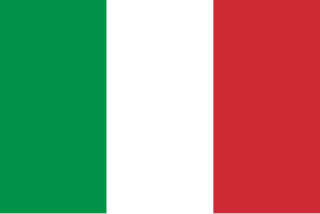
The Flag of Italy, often referred to as The Tricolour, is a tricolour featuring three equally sized vertical panels of green, white and red, with the green at the hoist side, as defined by Article 12 of the Constitution of the Italian Republic. The Italian law regulates its use and display, protecting its defense and providing for the crime of insulting it; it also prescribes its teaching in Italian schools together with other national symbols of Italy.

The Senyera is a vexillological symbol based on the coat of arms of the Crown of Aragon, which consists of four red stripes on a yellow field. This coat of arms, often called bars of Aragon, or simply "the four bars", historically represented the King of the Crown of Aragon.
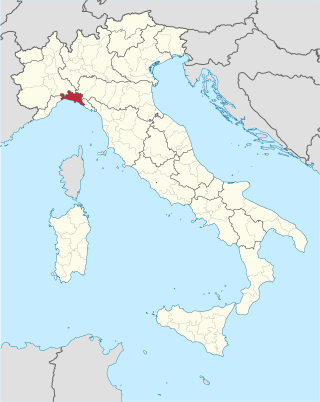
The province of Genoa was a province in the Liguria region of Italy. Its capital was the city of Genoa. It was replaced by Metropolitan City of Genoa.
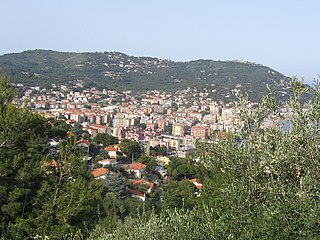
Andora or Marina di Andora is a town on the Italian Riviera in the region of Liguria, included in the province of Savona.
The twenty Italian regions each have their own arms, as well as their own gonfalone; more recently they have taken into use normal flags as well. Many regional flags were adopted on 4 November 1995 for National Unity and Armed Forces Day of Italy.

The emblem of the Italian Republic was formally adopted by the newly formed Italian Republic on 5 May 1948. Although often referred to as a coat of arms, it is an emblem as it was not designed to conform to traditional heraldic rules. The emblem is used extensively by the Italian government.
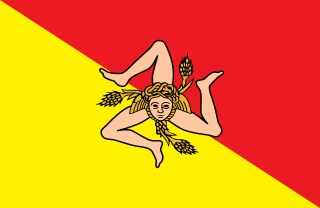
The flag of Sicily shows a triskeles symbol, and at its center a Gorgoneion with a pair of wings and three wheat ears. In the original flag, the wheat ears did not exist and the colors were reversed. The original flag was created in 1282 during the rebellion of the Sicilian Vespers.

The Flags of Napoleonic Italy were the green, white and red tricolour flags and banners in use in Italy during the Napoleonic era, which lasted from 1796 to 1814. During this period, on 7 January 1797, the green, white and red tricolour was officially adopted for the first time as a national flag by a sovereign Italian state, the Cispadane Republic. This event is commemorated by the Tricolour Day.

The flag of Sardinia, also referred to as the Four Moors, represents and symbolizes the island of Sardinia (Italy) and its people. It was also the historical flag and coat of arms of the Aragonese, then Spanish, and later Savoyard Kingdom of Sardinia. It was first officially adopted by the autonomous region in 1950 with a revision in 1999, describing it as a "white field with a red cross and a bandaged Moor's head facing away from the hoist in each quarter".

Tricolour Day, officially National Flag Day, is the flag day of Italy. Celebrated on 7 January, it was established by Law 671 on 31 December 1996. It is intended as a celebration, though not a public holiday. The official celebration of the day is held in Reggio Emilia, the city where the Italian tricolour was first adopted as flag by an Italian sovereign state, the Cispadane Republic, on 7 January 1797.

The flag of Umbria is one of the official symbols of the region of Umbria, Italy. The current flag was officially adopted on 18 March 2004, although the emblem and gonfalon had been in use since the 1970s. The Regional Law of 18 May 2004 officially confirmed the flag and added the words Regione Umbria in red, centered in the bottom fifth of the flag, but in common usage, the words are omitted.

The flag of Emilia-Romagna is one of the official symbols of the region of Emilia-Romagna, Italy. The flag shows the coat of arms adopted in 1989 in the variant with green writing and red bar on a white background.

The flag of Lazio is one of the symbols of the region of Lazio, Italy. The flag is currently only de facto official, but is in common use.
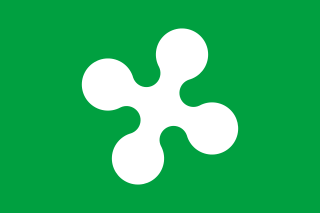
The flag of Lombardy is one of the official symbols of the region of Lombardy, Italy. The current flag was officially adopted on 4 February 2019, although it has been used de facto since 12 June 1975.

The flag of Tuscany is the official flag of the region of Tuscany, Italy. The flag depicts a silver Pegasus rampant on a white field between two horizontal red bands. The flag first appeared as a gonfalon on 20 May 1975 along with accompanying text Regione Toscana above the Pegasus. It was officially adopted as the flag of Tuscany on 3 February 1995.
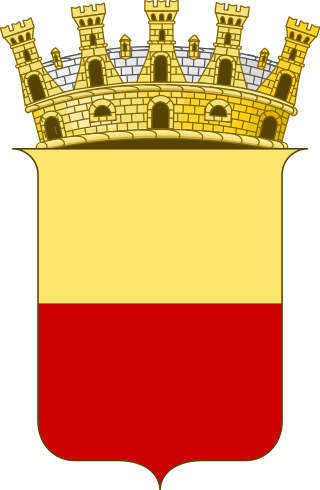
The coat of arms of Naples consists of a Samnite shield divided horizontally in half with the upper part in gold and the lower half in red. The shield is stamped with a turreted city crown of the type in use before the Royal decree n. 652 of June 7, 1943.

























